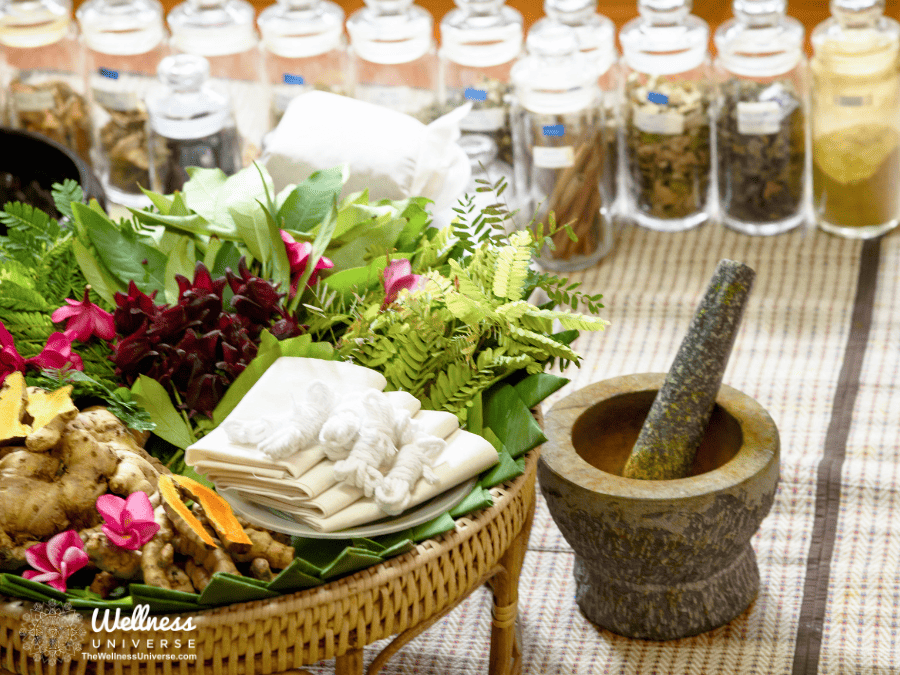Ayurveda’s foundational philosophy is grounded in the belief that optimal health is achieved when there is a harmonious balance between the mind, body, and spirit. It recognizes that everyone is a unique combination of physical, mental, and emotional attributes, and thus offers personalized approaches to healing and well-being. Central to Ayurvedic teachings are the doshas—Vata, Pitta, and Kapha—which are believed to govern various aspects of human physiology and psychology.
These doshas represent subtle energies that influence everything from digestion and metabolism to personality traits and emotional tendencies. Understanding one’s doshic constitution, or Prakriti, is essential in Ayurveda for tailoring lifestyle choices, including diet, exercise, and daily routines, to maintain balance and prevent illness.
Ayurveda emphasizes preventive healthcare, advocating for practices that promote longevity and vitality. It recognizes the interconnectedness between the individual and the environment, prescribing lifestyle adjustments in accordance with the changing seasons and stages of life. By addressing the root cause of imbalances rather than merely treating symptoms, Ayurveda seeks to restore harmony and promote holistic well-being at all levels of existence.
At its core, Ayurveda is not just a medical system, but a profound philosophy that acknowledges the inseparable connection between the individual and the universe. By aligning with the rhythms of nature and honoring the innate wisdom of the body, Ayurveda offers a timeless path to health, happiness, and spiritual fulfillment.
Understanding the Doshas
According to Ayurvedic teachings, each individual possesses a unique combination of three primary doshas: Vata, Pitta, and Kapha. These doshas are manifestations of the five elements—ether, air, fire, water, and earth—and govern distinct aspects of human physiology and psychology. Understanding the nature of these doshas is essential for maintaining equilibrium and vitality.
- Vata: Characterized by the elements of ether and air, Vata governs movement, creativity, and communication within the body. When in balance, individuals with a predominant Vata constitution exhibit traits of liveliness, imagination, and flexibility. However, an excess of Vata can lead to manifestations such as anxiety, dry skin, and digestive disturbances.
- Pitta: Comprised of fire and water elements, Pitta governs metabolism, digestion, and transformation. Pitta-dominant individuals are often characterized by ambition, focus, and assertiveness. Imbalances in Pitta may manifest as irritability, inflammation, and digestive disorders.
- Kapha: Formed by earth and water elements, Kapha governs stability, structure, and lubrication in the body. Those with a dominant Kapha constitution tend to exhibit qualities of nurturing, groundedness, and compassion. Excessive Kapha, however, can lead to lethargy, weight gain, and congestion.
Balancing Doshas Through Nutrition
Ayurveda underscores the profound impact of diet on doshic balance and overall well-being. By selecting foods that harmonize with one’s doshic constitution, individuals can optimize their health and vitality.
Balancing Vata
Vata individuals benefit from warm, nourishing foods that counteract their inherently cold, dry nature. Incorporating cooked grains such as rice and oats, along with cooked vegetables like sweet potatoes and carrots, provides grounding nourishment. Additionally, warming spices like ginger, cinnamon, and cumin help pacify Vata dosha, promoting balance and vitality. Healthy fats such as ghee and sesame oil offer lubrication and support for dryness, while raw and cold foods, excessive caffeine, and stimulants should be avoided to prevent Vata aggravation.
Balancing Pitta
Given Pitta’s fiery disposition, individuals with a dominant Pitta constitution benefit from cooling and soothing foods that mitigate excess heat and acidity. Incorporating sweet fruits like ripe mangoes and melons, as well as leafy greens like kale and spinach, helps pacify Pitta dosha. Cooling herbs such as cilantro and mint can further support digestion without overheating the body. Mild spices like coriander, fennel, and cardamom offer flavor and digestive support, while spicy, sour, and oily foods, along with alcohol and caffeine, should be minimized to prevent Pitta imbalances.
Balancing Kapha
Kapha individuals thrive on foods that are light, dry, and invigorating, counteracting their inherent heaviness and sluggishness. Pungent, bitter, and astringent tastes stimulate metabolism and reduce congestion in Kapha dosha. Including legumes, cruciferous vegetables like broccoli and Brussels sprouts, and spices like black pepper, ginger, and turmeric in the diet supports Kapha balance. Opting for lighter grains such as quinoa and barley over heavier ones like wheat and rice helps prevent exacerbation of Kapha imbalances. Heavy, oily, and sweet foods, as well as dairy and excess salt, should be minimized to maintain Kapha equilibrium.
Incorporating Ayurvedic Principles into Daily Life
Ayurvedic nutrition is deeply rooted in the ancient wisdom of Ayurveda, which views health as a dynamic equilibrium between the body, mind, and spirit.
Here’s an expanded view:
- Customized Approach: Ayurveda recognizes that each person has a unique constitution, or dosha, which influences their physical and mental attributes. By understanding one’s doshic balance, individuals can tailor their diet to promote harmony and address imbalances.
- Holistic Well-being: Unlike conventional approaches that focus solely on physical symptoms, Ayurvedic nutrition considers the holistic well-being of an individual, encompassing physical, mental, and spiritual aspects. This comprehensive approach aims to restore balance and vitality on all levels.
- Dietary Guidelines: Ayurveda offers specific dietary recommendations based on the qualities of foods and their effects on the doshas. By incorporating a variety of tastes, textures, and qualities into meals, individuals can maintain doshic balance and support optimal health.
- Spiritual Connection: Ayurvedic nutrition emphasizes the interconnectedness of the body, mind, and spirit. By nourishing the body with wholesome foods aligned with one’s doshic constitution, individuals can enhance their spiritual awareness and inner harmony.
- Lifestyle Integration: Ayurvedic nutrition is not just about what you eat but also how you live. It encourages mindful eating practices, stress management, adequate sleep, and regular exercise to promote overall well-being.
By integrating Ayurvedic principles into their daily lives, individuals embark on a journey of self-discovery and holistic wellness.
Ayurveda encourages individuals to develop a deeper understanding of their bodies, minds, and spirits. Through mindful observation and introspection, they gain insight into their unique constitutions and imbalances, paving the way for personalized healing and growth. Adopting an Ayurvedic lifestyle involves aligning daily routines, diet, and activities with natural rhythms and seasons. By living in harmony with nature’s cycles, individuals cultivate a sense of balance and vitality in their lives. Ayurveda recognizes the intimate connection between the mind and body, emphasizing practices that promote mental clarity, emotional stability, and physical well-being. Techniques such as meditation, yoga, and pranayama foster a deeper connection to oneself and the world around them. Through consistent application of Ayurvedic principles, individuals experience transformative shifts in their health, relationships, and overall quality of life.
This journey of self-discovery and healing leads to profound inner growth and a renewed sense of vitality and purpose. In essence, embracing Ayurveda unlocks the potential for profound transformation, empowering individuals to lead lives of greater vitality, balance, and well-being.
Works Cited
- Ayurvedic Nutrition: Balancing Doshas for Optimal Well-being
- Ayurveda | Johns Hopkins Medicine
- A glimpse of Ayurveda – The forgotten history and …
- Ayurveda: Unlocking the Secrets to Holistic Well-being
- What is the Philosophy of Ayurvedic Medicine?
All information, content, and material are for informational purposes only and are not intended to serve as a substitute for the consultation, diagnosis, and/or medical treatment of a qualified physician or healthcare provider. The information supplied through or on this page, or by any representative or agent of The Wellness Universe, is for informational purposes only and does not constitute medical, legal, or other professional advice. Health-related information provided through this website is not a substitute for medical advice and should not be used to diagnose or treat health problems or to prescribe any medical devices or other remedies. The Wellness Universe reserves the right to remove, edit, move, or close any content item for any reason, including, but not limited to, comments that are in violation of the laws and regulations formed pursuant to the Federal Food, Drug, and Cosmetic Act. None of the posts and articles on The Wellness Universe page may be reprinted without express written permission.
High Vibration Living – Leaders Bridging Inner & Outer Peace
Each session includes powerful, life-enhancing stories, personal interaction, transformative exercises, and time for reflection to integrate what you’ve learned.
Learn more here –

see how our self-care books are helping thousands of people around the world. Digital and paperback books are available now.
Connect to the people that help you live your best life: The Wellness Universe
The Wellness Universe is your resource for health, wellness, well-being, and transformation. We serve and support professionals who make the world a better place and individuals and groups who seek their best life.
A woman owned company; having the vision in 2013, Anna Pereira launched the first directory in 2015 bringing together a community of members making the world a better place to be found by those seeking their best life. The Wellness Universe has grown since then to be a one-stop shop for total wellness support! We are a vetted community, online directory, book publisher, resource center, event producer, content platform, and so much more, supporting whole-health and well-being on a global scale.
The Wellness Universe is a home that connects industry professionals in the health, wellness, and well-being fields to seekers of total well-being. WU provides our WU World-Changer members with peer support, Wellness Universe produced events (live and online), projects, visibility, business mentoring, and community. Through The Wellness Universe our WU World-Changer members serve WU Friends, seekers of health, wellness and transformation, with coaching, workshops, content and more.
The Wellness Universe provides individuals and groups seeking their best lives with access to our members, wellness content, educational resources, and guidance in all areas of wellness to transform visions of how they want to live life into the life they experience.
Through the directory, WU Featured Blog, SoulTreat wellness retreat, Self-Care Books, group well-being programs, and online learning center, The Lounge, The Wellness Universe provides many avenues to support whole health, mind, body, spirit and planet.
Join us today! Wellness Professional or Seeker of Your Best Life




